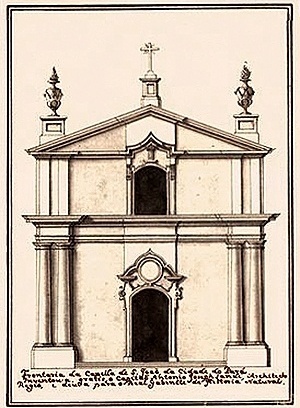Chapel Saint John, The Baptist
The Chapel of Saint John was one of the first churches in Belém, as registered by the date of its construction, initiated in 1622. There, Priest Vieira was arrested in 1661, and Friar Bartolomeu do Pilar was consecrated the first Bishop of Belém, in 1777. Although it was a small rammed earth chapel, until its reconstruction in from 1772 to 1777 by Antônio Landi (1713-1791), it was once used as a mother church, during the Cathedral's construction works. Considered a jewel of architecture by Bazin, the current church's façade follows the trends of Classicizing Baroque, coherent with its author's academic background in Bologna's Clementine Academy.
The floor plan - comprised of two overlapping squares, of which the largest is the nave, shaped on the inside as an irregular octagon, and the smallest is the high chapel, sided by annexes - is the most distinctive feature of this 19 th -century project The dome, as one of the few instances in local architecture, follows octagonal shape of the nave,and features windows in four of its panes. Two altars are installed on the nave's widest panes. These altars, as well as the wall behind the main altar, feature the main attraction of this small religious building: the paintings in Trompe loeil or illusionist paintings, made by Landi in the 18 th century.
Hidden for decades, these paintings were located in a survey in 1987, and restored in 1996, when the tones of pink and green emulating marble were recovered. The drawings feature motifs typical of Landi, implicating his connections to the Bibiena family, renowned scenographers in 18 th - century Europe. Vases and garlands with flowers and inverted volutes appear next to a halo with the symbols of the Holy Spirit, a motif found in other works by the architect. Niches,balustrades and windows were carefully designed to enhance the illusion of depth and of the nonexistent openings. Natural Lighting was planned to highlight the scenographic effects of this illusionist painting. On the main altar and on the side altars there are two frames that used to be around canvases, both alluding to the life of Saint John. A third canvas, now lost, supposedly dealt with the same theme. These paintings were done in Lisbon, in 1774, by Portuguese painter Francisco de Figueiredo.
The Great Bishop Dom Bartolomeu do Pilar that died in 1773 was buried in this chapel. Later on in 1774 his body was transfered to Saint Alexander Church.
